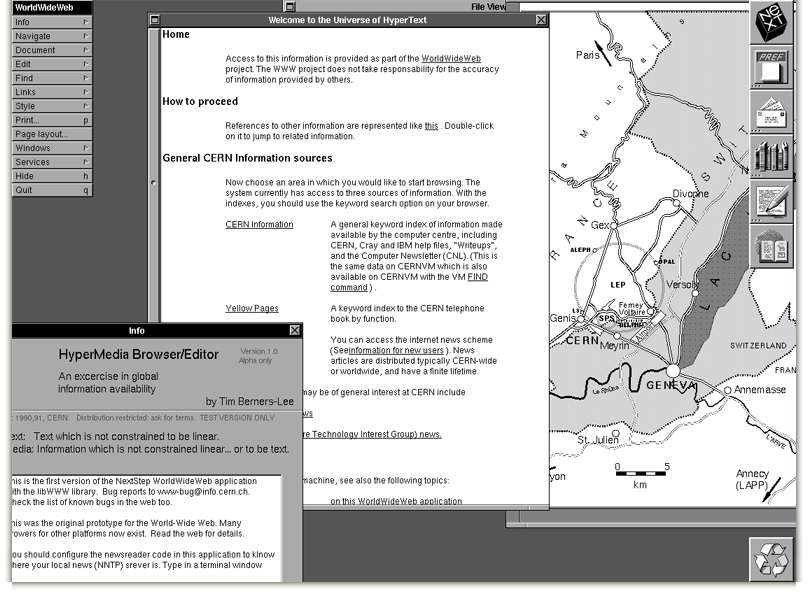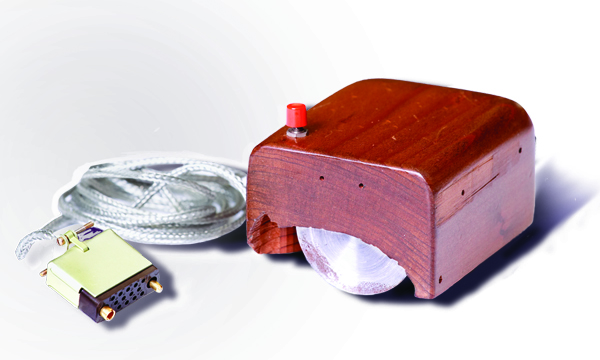As We May Think
12. 3. 2019Large hypertext database with typed links ↓
Berners-Lee wrote a proposal in March 1989 for “a large hypertext database with typed links”. Although the proposal attracted little interest, Berners-Lee was encouraged by his boss, Mike Sendall, to begin implementing his system on a newly acquired NeXT workstation. He considered several names, including Information Mesh, The Information Mine or Mine of Information, but settled on World Wide Web.
By Christmas 1990, Berners-Lee had built all the tools necessary for a working Web: the HyperText Transfer Protocol (HTTP) 0.9, the HyperText Markup Language (HTML), the first Web browser (named WorldWideWeb, which was also a Web editor)
Web was originally read-write.

https://en.wikipedia.org/wiki/History_of_the_World_Wide_Web
I just had to take the hypertext idea and connect it to the Transmission Control Protocol and domain name system ideas and—ta-da!—the World Wide Web … Creating the web was really an act of desperation, because the situation without it was very difficult when I was working at CERN later. Most of the technology involved in the web, like the hypertext, like the internet, multifont text objects, had all been designed already. I just had to put them together. It was a step of generalising, going to a higher level of abstraction, thinking about all the documentation systems out there as being possibly part of a larger imaginary documentation system.
https://en.wikipedia.org/wiki/Tim_Berners-Lee
Berners-Lee is one of the pioneer voices in favour of net neutrality, and has expressed the view that ISPs should supply “connectivity with no strings attached”, and should neither control nor monitor the browsing activities of customers without their expressed consent.
And the first page
http://info.cern.ch/hypertext/WWW/TheProject.html
More
https://www.w3.org/History/19921103-hypertext/hypertext/WWW/DesignIssues/Overview.html
https://www.w3.org/People/Berners-Lee/FAQ.html
^ Note the weird html source of this pages (missing head, body tags)
Hypertext ↓
Starting in 1963, Ted Nelson developed a model for creating and using linked content he called “hypertext” and “hypermedia” (first published reference 1965)
1968, Engelbart demonstrated a hypertext interface to the public for the first time, in what has come to be known as “The Mother of All Demos”.

In 1992, Lynx was born as an early Internet web browser. Its ability to provide hypertext links within documents that could reach into documents anywhere on the Internet began the creation of the Web on the Internet.
# Still kicking in 2019
lynx -nocolor -use-mouse https://brontosaurusrex.github.io/2019/03/12/Information-Mesh/
In 1995, Ward Cunningham made the first wiki available, making the Web more hypertextual by adding easy editing, and (within a single wiki) backlinks and limited source tracking. It also added the innovation of making it possible to link to pages that did not yet exist.
The Firefox Add-On Hyperwords which has been developed in cooperation with Doug Engelbart and Ted Nelson gives Web surfers the ability to issue many commands on any text on the web, not only pre-written links—a return to what users could do 40 years earlier with Doug Engelbart’s NLS.
https://en.wikipedia.org/wiki/History_of_hypertext
Berners-Lee’s links were designed to be one-way, unlike the two way hyperlinks first suggested by Ted Nelson. In Nelson’s ongoing Project Xanadu, “links must be bivisible and bifollowable,” says Barnet, “capable of being seen and followed from the destination document as well as the originating document.” And Nelson went further, with a method of citing text or media by integrating parts of the original into the first ‘window’ or ‘document’, something he refers to as a “parallel presentation” in Werner Herzog’s documentary Lo and Behold: Reveries of the Connected World. These were hyperlinked so that the user could click through to get the full context with a mechanism for micropayments to the original author.
The Semantic Web, first proposed by Berners-Lee in 1994, moves away from 20th-century ideas of interlinked documents and pages towards a web of data, that can be processed by machines.. Barnet similarly suggests a “more intelligent linking system”, something she says the Semantic Web is seeking to rectify: “Is there a more efficient way of linking that could identify content by what it is, not just where it is?”
https://www.wired.co.uk/article/google-link-hyperlink-seo
As We May Think ↓
The world has arrived at an age of cheap complex devices of great reliability; and something is bound to come of it.
Vannevar Bush july 1945 issue
The memex would provide an “enlarged intimate supplement to one’s memory”. The concept of the memex influenced the development of early hypertext systems (eventually leading to the creation of the World Wide Web) and personal knowledge base software. The hypothetical implementation depicted by Bush for the purpose of concrete illustration was based upon a document bookmark list of static microfilm pages and lacked a true hypertext system, where parts of pages would have internal structure beyond the common textual format. Early electronic hypertext systems were thus inspired by memex rather than modeled directly upon it.
Engelbart believes that human beings live within an existing technical and cultural system, an ‘augmentation’ system. We are born with a particular set of genetic capabilities, and then we build on these innate capabilities using tools, techniques, skills, language and technology. There is no ‘naked ape’; from the moment we are born we are always already augmented by language, tools and technologies. This augmentation system defines the limits of what is possible for us as a species.
Engelbart claimed it was Bush’s concept of a ‘co-evolution’ between humans and machines, and also his conception of our human ‘augmentation system’, that inspired him (Engelbart 1999).
Quoted from Memory machines.
Xanadu ↓
It was a vision in a dream. A computer filing system that would store and deliver the great body of human literature, in all its historical versions and with all its messy interconnections, acknowledging authorship, ownership, quotation and linkage. Like the Web, but much better: no links would ever be broken, no documents would ever be lost, and copyright and ownership would be scrupulously preserved. The Magical Place of Literary Memory: Xanadu. In this place, users would be able to mark and annotate any document, see and intercompare versions of documents side by side, follow visible hyperlinks from both ends (‘two-way links’) and reuse content pieces that stay connected to their original source document. There would be multiple ways to view all this on a computer screen, but the canonical view would be side-by-side parallel strips with visible connections (‘visible beams’). Just imagine. This vision – which is actually older than the Web, and aspects of it are older than personal computing – belongs to hypertext pioneer Theodor Holm Nelson, who dubbed the project Xanadu in October 1966.
Imagine if the same item could appear in multiple places. You could connect each item to its original by an addressing method and retrieve them on a computer screen. Because this would be reuse by reference rather than by copying, you could trace each item back to its original source. This idea – that you should be able to see all the contexts of reuse, and that you should be able to trace items back to their original source – would ‘drive my work to the edge of madness’ (Nelson 2010c, 104). It would later become the kernel of Nelson’s most innovative idea: transclusion. Transclusion, and also the ability to visually compare prior or alternative versions of the same document on screen (‘intercomparison’) were integral to the design of Xanadu.

To Nelson’s dismay, Xanadu has (unfairly) been hailed as ‘the longest-running vaporware project in the history of computing’ (Wolf 1995).
Nelson is often accused of hand waving and lucid dreaming, but Xanadu has nonetheless become the most important vision in the history of computing.
Quoted from Memory machines.
Thoughts ↓
One dream in particular has recurred throughout this book: a device that ‘enables associative connections that attempt to partially reflect the ‘intricate web of trails carried by the cells of the brain’ (Wardrip-Fruin 2003, 35). More precisely, a tool for thought – a tool that might organize the mass of deeply tangled data that surrounds us. For the world grows more and more complex every day, and the information we are expected to keep track of proliferates at every click. How are we to keep track of the mess? The problem that Bush identified in 1945 is just as urgent today.
Quoted from Memory machines.
